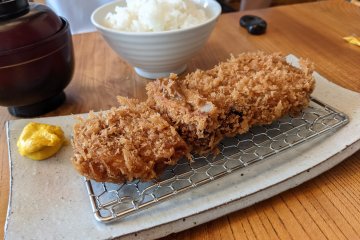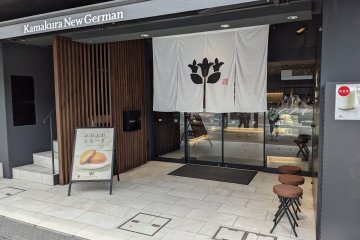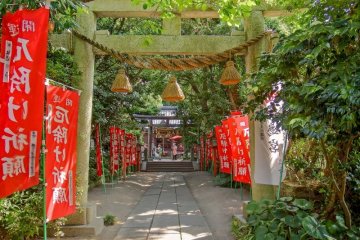
Aratama
Taste Aratama's famous fried pork cutlet and fall in love with the fresh flavors. Tonkatsu isn't all that's on the menu. Be sure to try Aratama's other dishes like mozzarella menchi katsu and cream croquette.

Hongakuji Temple (本覚寺) is dedicated to Ebisu, part of the Kamakura seven deities of good luck. The temple was founded by Ashikaga Mochiuji in 1436.

Taste Aratama's famous fried pork cutlet and fall in love with the fresh flavors. Tonkatsu isn't all that's on the menu. Be sure to try Aratama's other dishes like mozzarella menchi katsu and cream croquette.

Discover the taste that Kamakura locals are in love with. New German's fluffy custard-filled sponge cakes are a dessert that is sure to impress. The caramel custard flavor is especially popular with visitors.

At the creative French restaurant, Nature et Sens, diners are treated to an experience for the senses. Seasonal ingredients and Kamakura produce take centerstage in these fantastically beautiful dishes. Enjoy a glass of wine with your meal from their wide selection for the ultimate experience.

Yakumo Shrine, also called Yakumo Jinja, was established around 1082 by Yoshimitsu Minamoto—a Minamoto clan samurai during the Heian Period—and is believed to be the oldest talismanic shrine in Kamakura. It is located in the Omachi neighborhood and is said to ward off bad luck. Yoshimitsu Minamoto founded the shrine to help protect the people of Kamakura against the many epidemics that had taken hold of the area. The shrine represented a branch of Gion Shrine (modern day Yasaka Shrine) in Kyoto, which was known for its protection against illnesses. When the severity of Kamakura’s epidemics lessened in 1084, the shrine became a popular spot to repel bad luck. Today, the shrine is a small, quiet, and off-the-beaten-path spot to pray for good luck. Enjoy the peaceful grounds and be sure to collect a red Goshuin stamp at the shrine’s office to commemorate your visit.

Myohonji, located in the heart of Kamakura, is one of the oldest Nichiren-sect temples of Japanese Buddhism. Despite its city location, the temple is renowned for its tranquil atmosphere and lush encircling nature. It also tends to be less touristy than other temples in the area. Myohonji was founded in 1260 by Hiki Yoshimoto after he encountered the Buddhist priest and philosopher Nichiren Shonin in Kamakura. The site of the temple was previously home to the Hiki clan, before they were defeated by the Hojo clan in the early 1200s. Hiki Yoshikazu donated his home to Nichiren Shonin for the souls of his fallen clan, which later grew to be Myohonji. Some notable structures include Soshido, Myohonji’s largest temple building, Nitenmon gate, a beautiful inner gate, and a bronze statue of Nichiren. Enjoy the temple grounds in all seasons with spring cherry blossoms, verdant summer foliage, fiery autumn maple and ginkgo leaves, and winter plum blossoms.

El santuario Tsurugaoka Hachimangu es el santuario sintoísta más importante de la ciudad de Kamakura, prefectura de Kanagawa. El santuario está ubicado en el centro geográfico y cultural de la ciudad, que se construyó en gran parte a su alrededor. Tiene más de 800 años y está dedicado a Hachiman, Dios patrono de los samuráis. El santuario fue fundado por Minamoto Yoriyoshi en 1063 y ampliado y trasladado a su ubicación actual en 1180 por Minamoto Yoritomo, el fundador y primer shogun del gobierno de Kamakura. En la sala principal hay un pequeño museo santuario, en el que se exhiben diversos tesoros como; espadas, máscaras y documentos importantes. Varios eventos tienen lugar a lo largo del año. Más de dos millones de visitantes llegan durante las vacaciones de Año Nuevo y a mediados de Abril y mediados de Septiembre se muestra el tradicional tiro con arco a caballo (yabusame).